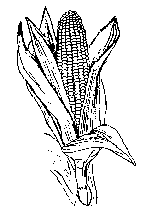
Year 2005: You go to your neighbourhood grocery store, ask for bread you get it in a polethelene bag. Source of polyethlene: Petroleum. Price: $60/barrel.
You throw the bag away, it stays there in the soil for the next thousand years.
Year 2015: You go to your neighbourhood Wal-Mart in Pune( most likely to happen!!!), buy some bread. You get it wrapped in Bio-polymer!!! Source of polymer: could be anything from corn waste or sugarcane waste to waste water from ag-processing industries!!! Price of crude oil: Considering that it was abt $40 till a few years back you can take a guess.
You throw the bag away in the soil, it decomposes!
My research at UND, is in modifying properties of poly lactic acid so that it can be used for food contacting operations, or soda pop bottles. So what is poly lactic acid? Poly lactic acid is a polymer obtained by polymerization of lactc acid. Lactic acid can be obtained from any bio mass, like corn.
The prospects of polylacticacid have got a lot of people excited throughout the world.
Over the last few decades, the interest in biodegradable and bioresorbable polymers has increased tremendously. According to the US Environmental Protection Agency 11.3 % of nearly 4.5 pounds/person/day of solid waste produced in the US is plastic waste. This translates in to a half pound of plastic waste generated per American per day.
Disposing of petroleum based polymers poses major environmental hazards due to formation of variety of hydrocarbons, and green house gases like CO2. As a result, most non-biodegradable plastics, like polyethylene, polypropylene and polystyrene end up in landfills and not much is recycled. Alsothese chemicals can slowly leach out, polluting the ground water and causing many health concerns.
Biodegradable polymers, however, can be decomposed in compost heaps, instead of being dumped in landfills. Not only that it is made from 100% renewable resources (made by photosynthesis in plants using sunlight). Also due to increasing costs of crude oil and decresing costs of manufacturing these polymers, they are likely to be much cheaper.
Cargill Dow has already set up a plant manufacturing 1400 tons/year PLA polymer at Blair Nebraska, made from corn growing in adjacent fields. This PLA is used to make food and non food packaging material, disposable cold drink cups, casing for laptops, walkmans, batteries, and also fibres for pillows, mattresses, casual and sports apparel, furnishings and much more.
The National Chemical Laboratories(NCL) in Pune has also developed the technology indigineously, and will be shortly applying for a US Patent.
Hence this is one material truly for the future.




3 comments:
Very informative indeed!
Biodegradable plastics are the future,but for now we must focus on recycling.
Hey suresh, could you tell me abt it in detail?
Nice and informative..
keep it up
Post a Comment